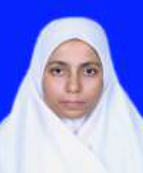

Name: Prof. Sabira Khatun
University/Department: University Malaysia Pahang, Malaysia
Research Area:
Wireless communications & Networks;
Ultra Wideband(UWB) technology;
Digital Signal Processing (DSP);
Artificial Intelligence (AI) with Deep Learning;
Biomedical Engineering along with Applications and System Developments.
Speech Title:Computer Aided Disease Diagnosis Systems using UWB and AI: Opportunities and
Challenges
Abstract:
The medical practitioners face many challenges using traditional diagnosing process, such as, X-ray,
MRI, CT Scans, Ultrasound, and IVUS in diagnosing respective diseases. Some of the diseases are
difficult to diagnose at early and/or any stage due to its similarity in sign and symptoms, such as, Lung
disease, early cancer/tumor screening, brain problems, early diabetes, etc. The solution is to use
computer sided diagnosis systems to aid the medical practitioner in their diagnosis process. Artificial
Intelligence (AI) with Deep Learning (DL) techniques are the current state-of-art in disease signature
detection, recognition, monitoring and classification problems, where it can be the algorithm in the
computer aided diagnosis. Ultra Wideband (UWB) is an attractive candidate for the use of noninvasive
bio-medical screening/applications due to its features including: a wide (3.1-10.6GHz)
bandwidth, use of very low power, can penetrate through any medium, bio-health friendly (including
human). There is widespread use of signal processing in medical field. Some of the motivations for this
is due to the need of processing large amounts of medical data generated during medical
examinations, and the variability in quality and expert opinions. Some challenges of (UWB) signal, and
image processing along with AI in the medical field need proper investigation. Due to use of UWB high
frequency, we have investigated and found some solutions on: how to handle the Nano pulses of UWB
signals for bio-medical application (with lossy/dispersive medium), necessity of underneath
technology extension, mitigation of interference from other health-devices, etc. Combining UWB and
AI, two of our example implementation strategies with promising results are: (i) Early breast
tumor/cancer diagnosis/screening at home to mitigate the major issues for women death worldwide,
and (ii) Non-invasive Blood Glucose Level Measurement and Monitoring (BGLM2) to reduce the health
consequences. Further investigation is needed on the possibility of non-invasive/non-destructive
computer aided techniques, their implementation challenges and opportunities in bio-health
including plant, food/grain, and personal digital health assistant (PDHA) system with predictive
analytics for human.
Short Bio:
With the ambition to be an academician, Prof. Sabira Khatun's research journey began with 'computational modelling’ of ‘hydromagnetic stratified fluid flow’ in 1990 during her first PhD study. Due to the strong interest towards mobile and wireless communications, Prof. Sabira Khatun obtained second PhD in the field of‘Communication and Network Engineering’ in 2003.
Research is a very dynamic process, as time passes, certain research areas become very salient and get attraction by researchers all over the world, while others become less attractive. Since 2003, by keeping in mind to contribute towards humankind, her research focuses changed dynamically (within the Communication and Network Engineering field) along the way as she try to work on problems which have practical applications towards the critical research field.